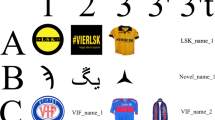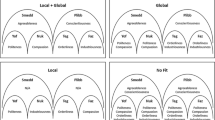Abstract
The current study used a factorial comparison experimental design to investigate conflicting findings on prototype effects shown by children with autism (Klinger and Dawson, Dev Psychopathol 13:111–124, 2001; Molesworth et al., J Child Psychol Psychiatry 46:661–672, 2005). The aim was to see whether children with high-functioning autism could demonstrate prototype effects via categorization responses and whether failure to do so was related to difficulty understanding ambiguous task demands. Two thirds of the autism group did show an effect. The remainder, a sub-group defined by performance on a control task, did not. The discussion focuses on the influence of heterogeneity within the autism group and the ability to resolve ambiguity on task performance. Finally, an alternative experimental design is recommended for further research into these issues.



Similar content being viewed by others
References
American Psychiatric Association. (1994). Diagnostic and statistical manual of mental disorders (4th ed.). Washington, DC: Author.
Baron-Cohen, S. (1988). Social and pragmatic deficits in autism: Cognitive or affective? Journal of Autism and Developmental Disorders, 18, 379–402.
Bennetto, L., Pennington, B. F., & Rogers, S. J. (1996). Intact and impaired memory functions in autism. Child Development, 67, 1816–1835.
Berger, H. J., Van Spaendonck, K. P., Horstink, M. W., & Buytenhuijs, E. L., et al. (1993). Cognitive shifting as a predictor of progress in social understanding in high-functioning adolescents with autism: A prospective study. Journal of Autism and Developmental Disorders, 23, 341–359.
Bowler, D. M., Gardiner, J. M., Grice, S., & Saavalainen, P. (2000). Memory illusions: False recall and recognition in adults with Asperger’s syndrome. Journal of Abnormal Psychology, 109, 663–672.
Bowler, D. M., Matthews, N. J., & Gardiner, J. M. (1997). Asperger’s syndrome and memory: Similarity to autism but not amnesia. Neuropsychologia, 35, 65–70.
Burack, J. A., Iarocci, G., Flanagan, T. D., & Bowler, D. M. (2004). On mosaics and melting pots: Conceptual considerations of comparison and matching strategies. Journal of Autism and Developmental Disorders, 34, 65–73.
Cabeza, R., Bruce, V., Kato, T., & Oda, M. (1999). The prototype effect in face recognition: Extension and limits. Memory and Cognition, 27, 139–151.
Dennis, M., Lazenby, A. L., & Lockyer, L. (2001). Inferential language in high-function children with autism. Journal of Autism and Developmental Disorders, 31, 47–54.
Dunn L. M., Dunn L. M., Whetton C., & Burley, J. (1997). The British picture vocabulary scale. London: NFER-Nelson.
Eales, M. J. (1993). Pragmatic impairments in adults with childhood diagnoses of autism or developmental receptive language disorder. Journal of Autism and Developmental Disorders, 23, 593–617.
Frith, U., & Snowling, M. (1983). Reading for meaning and reading for sound in autistic and dyslexic children. British Journal of Developmental Psychology, 1, 329–342.
Hampton, J. A. (1996). Conjunctions of visually based categories: Overextension and compensation. Journal of Experimental Psychology: Learning, Memory, and Cognition, 22, 378–396.
Hampton, J. A. (1997). Psychological representation of concepts. In M. A. Conway (Ed.), Cognitive models of memory studies in cognition (pp. 81–110). Cambridge, MA: The MIT Press.
Happé, F. (1995). The role of age and verbal ability in the theory of mind task performance of subjects with autism. Child Development, 66, 843–855.
Happé, F. (1996). Studying weak central coherence at low levels: Children with autism do not succumb to visual illusions: A research note. Journal of Child Psychology and Psychiatry, 37, 873–877.
Happé, F. (1997). Central coherence and theory of mind in autism: Reading homographs in context. British Journal of Developmental Psychology, 15, 1–12.
Hayes, B. K., & Conway, R. N. (2000). Concept acquisition in children with mild intellectual disability: Factors affecting the abstraction of prototypical information. Journal of Intellectual and Developmental Disability, 25, 217–234.
Hayes, B. K., & Taplin, J. E. (1993). Development of conceptual knowledge in children with mental retardation. American Journal on Mental Retardation, 98, 293–303.
Hermelin, B., & O’Connor, N. (1970). Psychological experiments with autistic children. Oxford: Plenum Press.
Hughes, C., Russell, J., & Robbins, T. W. (1994). Evidence for executive dysfunction in autism. Neuropsychologia, 32, 477–492.
Jarrold, C., & Brock, J. (2004). To match or not to match? Methodological issues in autism-related research. Journal of Autism and Developmental Disorders, 34, 81–86.
Jolliffe, T., & Baron-Cohen, S. (1999). A test of central coherence theory: Linguistic processing in high-functioning adults with autism or Asperger syndrome: Is local coherence impaired? Cognition, 71, 149–185.
Joseph, R. M., Tager-Flusberg, H., & Lord, C. (2002). Cognitive profiles and social-communicative functioning in children with autism spectrum disorder. Journal of Child Psychology and Psychiatry, 43, 807–821.
Klinger, L. G., & Dawson, G. (1995). A fresh look at categorization abilities in persons with autism. In E. Schopler & G. B. Mesibov (Eds.), Learning and cognition in autism (pp. 119–136). New York: Plenum Press.
Klinger, L. G., & Dawson, G. (2001). Prototype formation in autism. Development and Psychopathology, 13, 111–124.
Metcalfe, J., & Fisher, R. P. (1986). The relation between recognition memory and classification learning. Memory and Cognition, 14, 164–173.
Miller, J. N., & Ozonoff, S. (2000). The external validity of Asperger disorder: Lack of evidence from the domain of neuropsychology. Journal of Abnormal Psychology, 109, 227–238.
Minshew, N. J., Goldstein, G., Muenz, L. R., & Payton, J. B. (1992). Neuropsychological functioning nonmentally retarded autistic individuals. Journal of Clinical and Experimental Neuropsychology, 14, 749–761.
Molesworth, C. J., Bowler, D. M., & Hampton, J. A. (2005). The prototype effect in recognition memory: Intact in autism?. Journal of Child Psychology and Psychiatry, 46, 661–672.
Mottron, L. (2004). Matching Strategies in Cognitive Research with Individuals with High-Functioning Autism: Current Practices, Instrument Biases, and Recommendations. Journal of Autism and Developmental Disorders, 34, 19–27.
Murphy, G. L. (2002). The big book of concepts. Cambridge: MIT Press.
Omohundro, J. (1981). Recognition vs. classification of ill-defined category exemplars. Memory and Cognition, 9, 324–331.
Ozonoff, S., & Miller, J. N. (1995). Teaching theory of mind: A new approach to social skills training for individuals with autism. Journal of Autism and Developmental Disorders, 25, 415–433.
Plaisted, K. (2001). Reduced generalization in autism: An alternative to weak central coherence. In J. A. Burack, T. Charman, et al. (Eds.), The development of autism: Perspectives from theory and research (pp. 149–169). Mahwah, NJ: Lawrence Erlbaum Associates.
Posner, M. I., & Keele, S. W. (1968). On the genesis of abstract ideas. Journal of Experimental Psychology, 77, 353–363.
Ropar, D., & Mitchell, P. (2001). Susceptibility to illusions and performance on visuospatial tasks in individuals with autism. Journal of Child Psychology and Psychiatry, 42, 539–549.
Rosch, E. (1975a). Cognitive representations of semantic categories. Journal of Experimental Psychology: General, 104, 192–233.
Rosch, E. (1975b). The nature of mental codes for color categories. Journal of Experimental Psychology: Human Perception and Performance, 1, 303–322.
Rosch, E., Simpson, C., & Miller, R. S. (1976). Structural bases of typicality effects. Journal of Experimental Psychology: Human Perception and Performance, 2, 491–502.
Solso, R. L., & McCarthy, J. E. (1981). Prototype formation of faces: A case of pseudo-memory. British Journal of Psychology, 72, 499–503.
Surian, L., Baron-Cohen, S., & Van der Lely, H. (1996). Are children with autism deaf to Gricean maxims? Cognitive Neuropsychiatry, 1, 55–71.
Swettenham, J. (1996). Can children be taught to understand false belief using computers? Journal of Child Psychology and Psychiatry, 37, 157–165.
Tager-Flusberg, H. (1981). On the nature of linguistic functioning in early infantile autism. Journal of Autism and Developmental Disorders, 11, 45–56.
Tager-Flusberg, H. (1985a). Basic level and superordinate level categorization by autistic, mentally retarded, and normal children. Journal of Experimental Child Psychology, 40, 450–469.
Tager-Flusberg, H. (1985b). The conceptual basis for referential word meaning in children with autism. Child Development, 56, 1167–1178.
Tager-Flusberg, H. (1991). Semantic processing in the free recall of autistic children: Further evidence for a cognitive deficit. British Journal of Developmental Psychology, 9, 417–430.
Ungerer, J. A., & Sigman, M. D. (1987). Categorization skills and receptive language development in autistic children. Journal of Autism and Developmental Disorders, 17, 3–16.
Wing, L., & Gould, J. (1979). Severe impairments of social interaction and associated abnormalities in children: Epidemiology and classification. Journal of Autism and Developmental Disorders, 9, 11–29.
Younger, B. (1990). Infant categorization: Memory for category-level and specific item information. Journal of Experimental Child Psychology, 50, 131–155.
Acknowledgments
Thanks are due to the participants and their teachers for their invaluable assistance. Molesworth would also like to thank Claire Simmons for her comments on the data and on an earlier draft of this paper. The data presented here was submitted by Catherine Molesworth as part of her Ph.D. thesis (Department of Psychology, City University).
Author information
Authors and Affiliations
Corresponding author
Rights and permissions
About this article
Cite this article
Molesworth, C.J., Bowler, D.M. & Hampton, J.A. When Prototypes Are Not Best: Judgments Made by Children with Autism. J Autism Dev Disord 38, 1721–1730 (2008). https://doi.org/10.1007/s10803-008-0557-7
Received:
Accepted:
Published:
Issue Date:
DOI: https://doi.org/10.1007/s10803-008-0557-7




